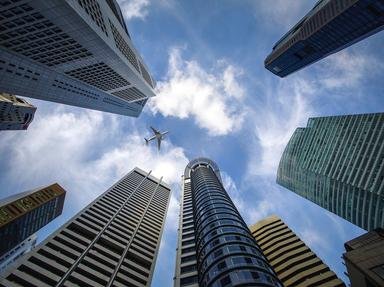Quiz Answer Key and Fun Facts
1. We start our world tour in North America, and a city noted as the meeting place of two rivers which then form another. Unsurprisingly, one of the city's nicknames is "City of Bridges". Named in honour of the 1st Earl of Chatham, who became Prime Minister of Great Britain shortly after the city was founded in 1758, which city's skyline is pictured here?
2. In its native language, the name of this Asian city literally means "Fragrant Harbour" (or "Incense Harbour"). Particularly known for its steep, hilly terrain, this is one of the world's most densely populated cities. It should come as no surprise, therefore, to hear that which city has more skyscrapers than any other?
3. Established in 1829, the city whose skyline is pictured here is home to some 2 million (2014 estimate). With an area of 2,478 square miles, the official boundaries of "The City of Light" encompass a region the size of Delaware. Named by a British statesman of the time in honour of his own birthplace, which city is this?
4. Founded in 1875 and incorporated as a city in 1894, the city of 1.1 million (2011 Census) stands at the confluence of the Bow River and the Elbow River. In 1988, it became the first city in its country to host the Winter Olympics. Named after a village on the Isle of Mull in Scotland, the name means "cold garden" in Old Norse. Which city is this?
5. Although the defacto seat of government since 1603, this city only officially became its national capital in 1868. More than a third of the city's land area is designated as National Park including one UNESCO World Heritage Site. The city's history means that the skyline is dominated by modern and contemporary architecture, including the world's second-tallest building when it opened in 2012. Which city is this?
6. Incorporated as a city in 1850, amongst its nicknames are "Fog City", "The City that Knows How" and "The Paris of the West". With a land area of less than 50 square miles, it is the second most densely populated major city in North America (after New York City). The name of its most successful sporting franchise reflects an important historical event in the region. Which city is this?
7. Settled since prehistoric times, the siting of this city was important as the furthest-downstream fording point of the river on which it stands. Over the past two centuries it has been a major international deep-water trading port and a hub of the shipbuilding industry. The city has four Christian cathedrals, each representing a different branch of the faith. Which city is this?
8. For a change, the photograph shows the city looking out over the bay rather than from it. One of the world's most multicultural cities, it was named the best place in the world to visit by both the 'New York Times' and the British 'Daily Telegraph' in 2014. Founded in 1652, it quickly grew to be the major European outpost in this part of the world. Which city is this?
9. Located on the banks of the Guaire River at between 2,500 and 3,000 feet above sea level, this capital city is nicknamed 'La Sucursal del Cielo' ("Heaven's Branch on Earth"). Founded by the Spanish in 1567, it is now home to many of the tallest skyscrapers in South America. Unfortunately, it also has one of the highest per capita murder rates in the world. Which city is this?
10. Like many European cities, the skyline of this national capital illustrates the contrast between the Old City, in the foreground here, and the skyscrapers of the modern city in the distance. Inhabited by humans since 500 BC, it became an important city after Duke Henry II Jasomirgott moved the Babenberg family residence here from Klosterneuburg in 1145. Which city, famous for its musical heritage, is this?
Source: Author
EnglishJedi
This quiz was reviewed by FunTrivia editor
spanishliz before going online.
Any errors found in FunTrivia content are routinely corrected through our feedback system.


